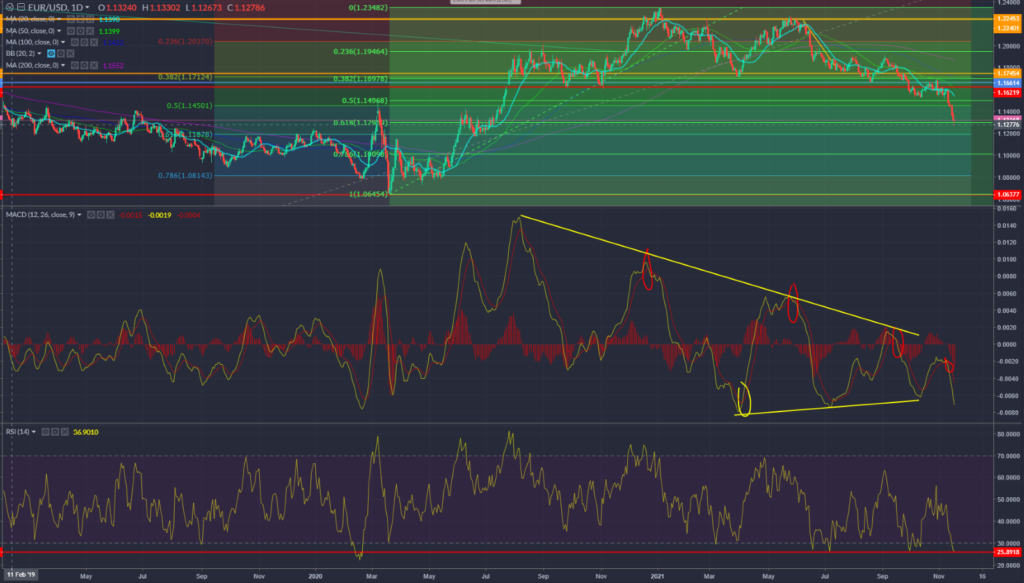
Wednesday Nov 17 2021 08:58

5 min
Chances the Bank of England raising interest rates next month increased as UK inflation surged to a 10-year high last month. October’s CPI inflation hit 4.2%, above the 3.9% estimated and well north of the Bank’s 2% target. It marked a steep acceleration from the 3.1% reading in September and underlines that inflation is becoming more of a problem, not less. Core inflation also surged to 3.4%. The good news is that pay is up 5.8%. Will the Bank raise rates next month? The MPC noted in November that the decision not to raise rates was largely because they wanted to get more information about the health of the labour market. So, coupled with the strong employment data yesterday, the case for the Bank of England to act now is compelling. That does not, however, mean a hike next month is a done deal – unreliableness breeds uncertainty even when it seems obvious. And we must stress that there are reasons to doubt the BoE will act: 1) there are still plenty on the MPC who are wedded to the transitory narrative – the Hawks v. Doves balance favours the latter camp still as the 7-2 vote indicated, 2) does the Bank think that hiking now would amount to a policy mistake a la Trichet? If so then even if they do feel that inflation is becoming unanchored and problematic, they may chicken out of hiking due to fears of killing off the recovery, and 3) do other risks to the economic outlook like Brexit mean hiking is simply not appropriate at this time? Whatever they think, the problem for the market is in not being able to trust statements about ‘acting on inflation’.
GBPUSD rose after the CPI was released but has pared a lot of those initial gains vs the dollar, but cable still trades mildly higher this morning. But the dollar is something of a brick wall right now so maybe not the best gauge – the pound is doing much better against the euro, hitting its best level since Feb 2020. Euro weakness is the main theme here so this is likely a much better play on sterling strength and monetary policy divergence than cable is given where Fed and ECB are right now.
European stock markets were flat/mixed at the start of the session after Wall Street rose on Tuesday following some strong retail sales numbers. We also had strong earnings from Walmart and Home Depot, which topped the Dow. Better-than-expected retail sales figures helped lift bond yields, with US 10s touching 1.65%, its highest in three weeks. Gold pulled back as a result, whilst the dollar is at its highest since July 2020.
The FTSE 100 trades lower by around 0.1-0.2% in early trade, whilst the DAX, CAC and Euro Stoxx 50 up by a similar kind of margin. Shares in Marks and Spencer traded –2% on a downbeat note from Jefferies, which downgraded the stock to hold from buy after the recent rally. They say the ‘easy lever of outsized earnings surprises on depressed multiples has been pulled’. This goes to what we talked about on the earnings update recently – easy wins behind, but much harder yards ahead in getting the stock back to 2015-18 levels.
Bullish note from Goldman Sachs on US equities, who forecast that the S&P 500 will climb by 9% to 5100 by the end of 2022. Kostin and co write: “The S&P 500 P/E multiple will remain roughly flat, ending 2022 at 21.6x. After two years of near-zero interest rates, the Fed will likely begin hiking in July. 10-year Treasury yields will rise to 2% by the end of next year, but be offset by a declining Equity Risk Premium as policy uncertainty declines and consumer confidence rises. Strong corporate and household demand for equities will help support valuation.”
GS’s top tips are: “(1) Own virus- and inflation-sensitive cyclicals; (2) Avoid high labor cost firms; (3) Buy growth stocks with high margins vs. low margin or unprofitable growth stocks.”
Tesla things … new filings showed Elon Musk sold almost $1bn more in stock as shares in Tesla rose 4%. Meanwhile, Tesla is being sued by JPMorgan for $162m over Musk’s ‘funding secured’ tweet and losses that ensued for the bank as a result of the stock price movement.
Chart: EURUSD tests key 61.8% retracement level of the move higher from March 2020 to January 2021 at around 1.1290, though the euro has pared earlier losses that saw it touch 1.1265. Nevertheless, any breaks below 1.13 keeps sellers in charge.

